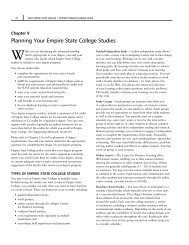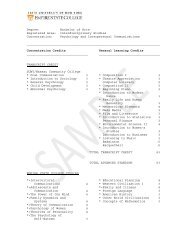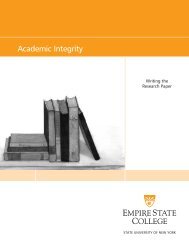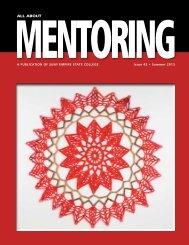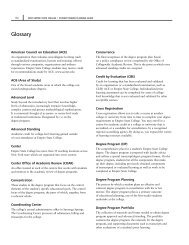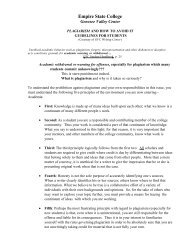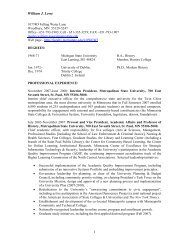All About Mentoring Spring 2011 - SUNY Empire State College
All About Mentoring Spring 2011 - SUNY Empire State College
All About Mentoring Spring 2011 - SUNY Empire State College
You also want an ePaper? Increase the reach of your titles
YUMPU automatically turns print PDFs into web optimized ePapers that Google loves.
4<br />
from peace to war and homes under aerial<br />
attack, escape, fear, coping, and anger<br />
directed at the enemy.<br />
Transition from Peace to War<br />
The first set of children’s drawings, depicting<br />
homes and surrounding areas under attack,<br />
are representative of many such drawings.<br />
They show air bombardment, face-toface<br />
combat, street bombs, and damaged<br />
buildings and people. Whether home is<br />
mud, thatch, wood, cement or brick, the<br />
drawings show remarkably similar scenes of<br />
air and ground attacks. The viewer is drawn<br />
into the scene, to the child’s clear depiction<br />
of his crumbled world. The drawings<br />
make it unhappily easy to enter the child’s<br />
psychological reality: loss of the assumed<br />
safety of home.<br />
During the Spanish Civil War in the late<br />
1930s, young Spaniards were evacuated to<br />
children’s colonies elsewhere in Spain or<br />
in neighboring France, away from active<br />
violence, where they attended school<br />
and drew pictures. One such child was a<br />
13-year-old girl, who drew a transitional<br />
moment from peace to war. Drawing 1<br />
depicts a peaceful town under aerial attack,<br />
mothers walking holding a child’s hand, two<br />
wounded or dead among the neat buildings,<br />
one building shattered, and a child covering<br />
her eyes.<br />
The child artist captures the new reality in<br />
great detail, juxtaposing orderliness and<br />
human care and attachment with destruction<br />
Drawing 1: Spain, Girl, age 13, 1937-38.<br />
and death. She<br />
skillfully presents<br />
a complex and<br />
nuanced scene,<br />
showing her ability<br />
to render scale<br />
and proportion.<br />
The pretty sturdy<br />
buildings evoke<br />
stability; the mother<br />
and child pairs<br />
evoke trust and<br />
care. The child artist<br />
surely intended to<br />
show innocence,<br />
unawareness of the<br />
threat that, in fact, has taken place around<br />
the corner. The picture centers on a child<br />
mid-page under a substantial verdant tree,<br />
covering her eyes, suggesting the wish to<br />
not see or accept what is happening around<br />
her. This drawing is a particularly fine<br />
illustration of the changed world faced<br />
by children in war and of the dawning<br />
awareness of the threat and what has been<br />
and will be lost.<br />
Another transitional drawing similarly<br />
shows normal life and its family bonds<br />
juxtaposed to aerial attack, damaged<br />
buildings and victims. Drawn during the<br />
wars in Yugoslavia (1991-1995) by an<br />
11-year-old boy from Zagreb, Croatia, it<br />
is titled “Mama, Wait for Me.” A bomber<br />
dominates the scene with a bomb below it<br />
on a direct trajectory to mother and child<br />
who are walking away from the yard and<br />
Drawing 2: Croatia, “Mama, Wait for Me.” Boy, age 11, c. 1991.<br />
the home with its shattered and dislodged<br />
windows. Another bomb is on a trajectory<br />
toward a child’s swing, as if symbolic of<br />
attack on the child and childhood pleasure.<br />
The next transitional illustration was drawn<br />
by a child from Darfur in 2005 (unknown<br />
age and sex) and again contains air and<br />
ground attacks. In this drawing, the scene<br />
is broader as if viewed from a distance and<br />
includes many huts and people. (Drawing 3)<br />
The roughly drawn huts and stick figure<br />
people stand in contrast to the more detailed<br />
bombers and ground attack vehicles, as if<br />
to emphasize the overpowering assault, the<br />
extent of damage, and the entire village<br />
having been victimized. Children often draw<br />
disturbing objects in greater detail than<br />
other parts of their pictures. (Drawing 3)<br />
Drawings 1-3 represent increasing<br />
dominance of wartime assaults. Drawing 1<br />
shows the contrast of peace and attack in<br />
a small town. Drawing 2 shows an aerial<br />
attack on a house that surely is meant to<br />
be the child artist’s. Drawing 3 shows the<br />
rampant bombing of an entire village in<br />
Darfur, Southern Sudan. Another Darfur<br />
drawing shows a family’s escape, which<br />
eventually brought them to a camp in Chad.<br />
Drawing 4 by a 9-year-old girl from Darfur<br />
shows victims holding each other. This<br />
drawing of escape emphasizes connection<br />
among family members. The child artist<br />
explained what she drew as people running<br />
from the Janjaweed, guns, planes and bombs<br />
“all together.” “<strong>All</strong> of us – my family –<br />
we were screaming and running from the<br />
Janjaweed … holding each other by the<br />
arms to keep together. Here in camp we<br />
are safe, but my father … was lost.” At the<br />
suny empire state college • all about mentoring • issue 39 • spring <strong>2011</strong>




